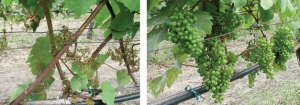
Left: The control vines of Madeleine Angevine, not tented. Right: This photo was taken the same day in August as the Madeleine Angevine control vine photo above, but these vines were tented.
he Sequim, Washington, vineyardist recommends installing the shrink-wrap envelope in the vineyard around the first of May, removing it around the first of July. Wrapping the vines with the shrink-wrap material hastens maturity by adding growing degree-days to the cool climate of the Puget Sound.
“It’s best to schedule the shrink-wrap for no more than 50 to 60 days,” he said, adding that tenting longer than 60 days may reduce yields.
Vines are treated normally once the wrap is taken off. The material is not reusable and must be disposed of when removed.
When shoots reach the trellis midwire, he opens the top of the wrap to reduce transpiration, condensation, and humidity. Thus far, powdery mildew hasn’t been a problem with plastic-wrapped vines.
Miller found that topping the shoots helps avoid early bunch stem necrosis, a problem he encountered the first year of experimenting with the plastic envelope.
Because he is forcing early flowering and shoot growth, the new shoots have a big demand for carbohydrates and tend to starve the fruit clusters for carbohydrates, he explained. “The first year, I ended up with a lot of early bunch stem necrosis,” he said. “The stems were shriveling and falling off because of the excess nitrogen and ammonium that had built up. The shoots were just getting fried.”
By cutting back the shoots that have grown above the midwire at flowering, the vine sends carbohydrates back to the fruit instead of keeping it in the shoots, he said. Since he began topping, he has prevented early bunch stem necrosis and increased fruit set.

Leave A Comment